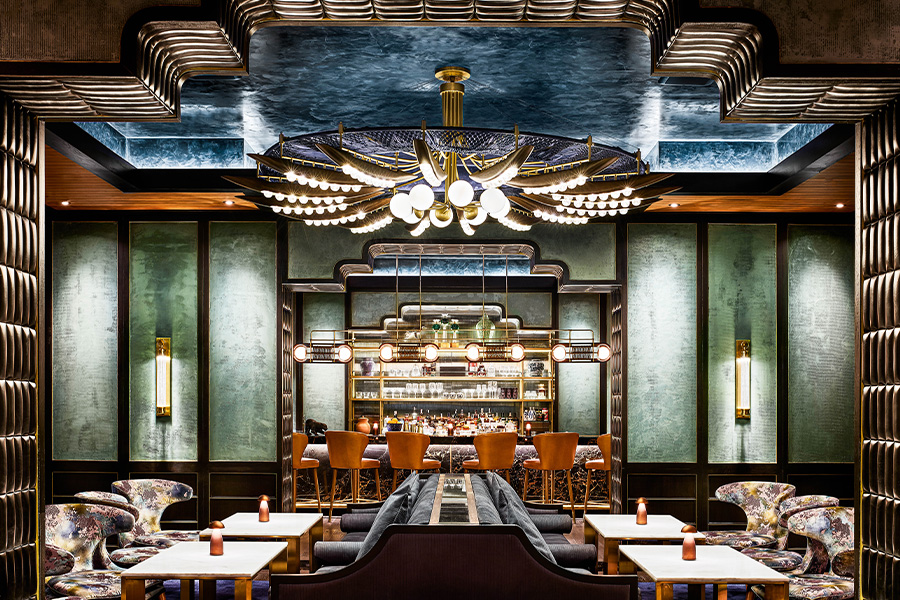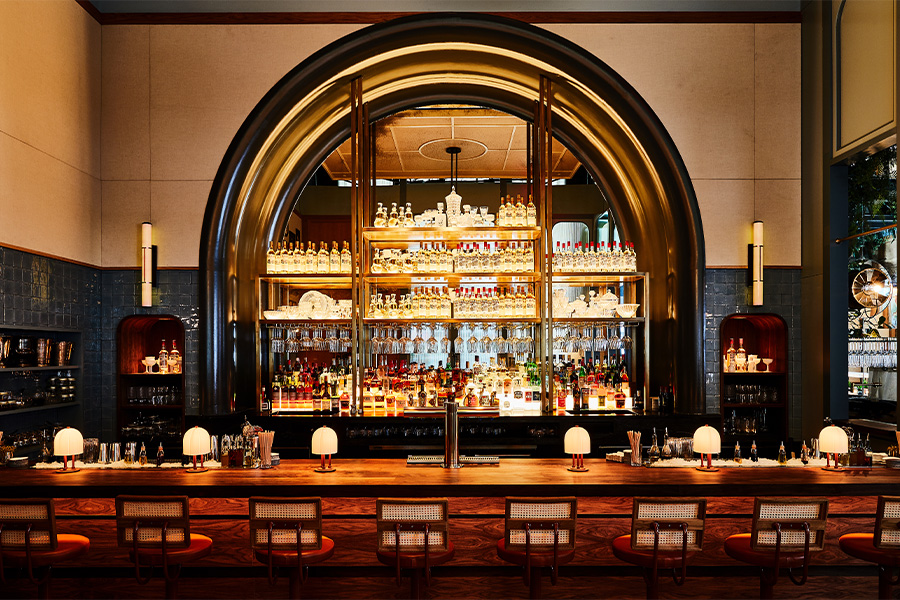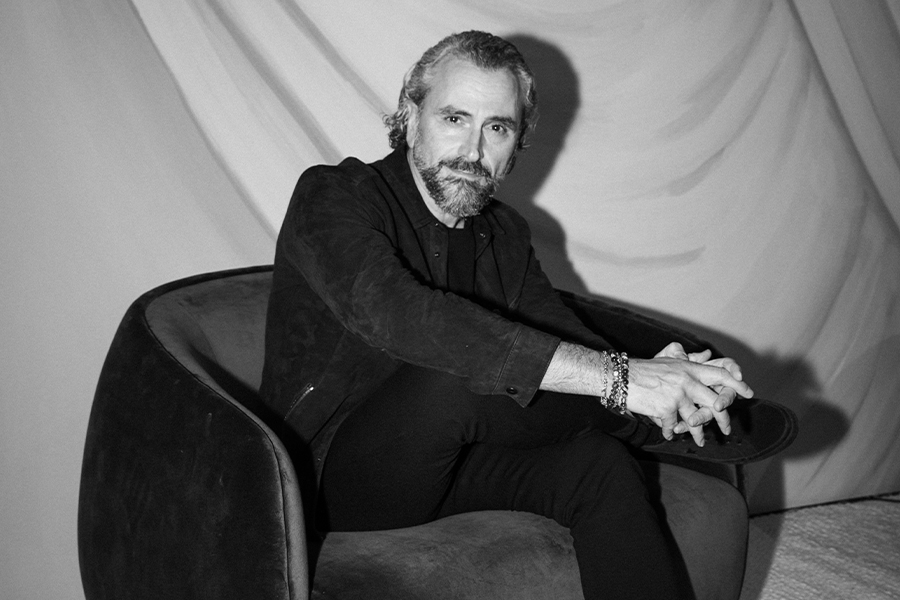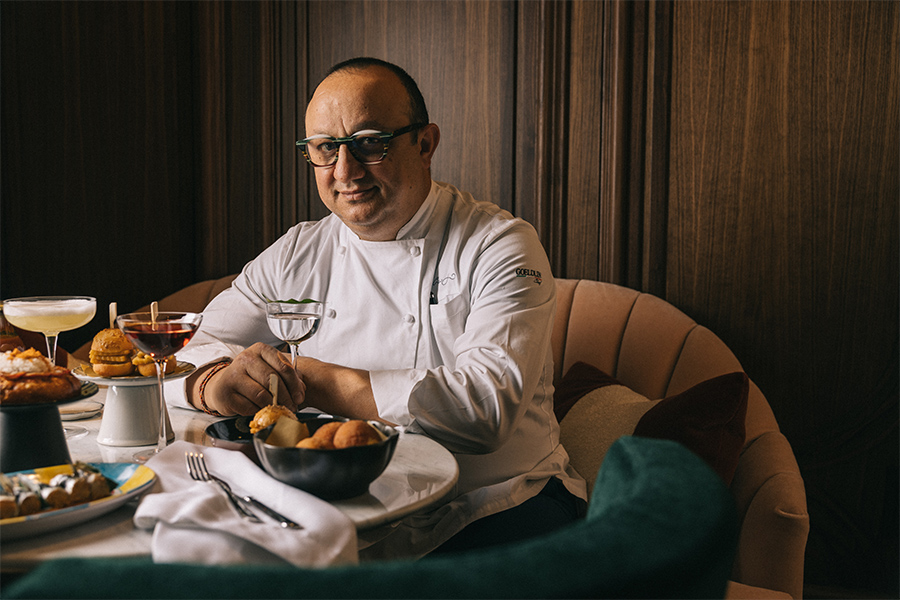Quarterly, the four principals of global design firm AvroKO—William Harris, Kristina O’Neal, Adam Farmerie, and Greg Bradshaw—sit down together for their partner summits where they envision and revise their “magic papers” and plan for the company’s future, an exercise that allows them to “thoughtfully extract passions, ideas, and dreams—it’s our way of framing what’s in our hearts and where we want things to go on an emotional level,” says O’Neal. Exploring those shifting desires and how they might intersect, is the main driver of AvroKO’s evolution over the last 20 years.
The foursome met at Carnegie Mellon University in Pittsburgh, where Bradshaw and Farmerie were on the architecture track and Harris and O’Neal were studying art. AvroKO (a mash-up of Avro Design and KO Media Studios, the companies they ran before joining forces) was founded in 2001, after the friends reunited in New York.
From the get-go, the firm stood out for its bold, integrated approach to design inspired by historic movements like Bauhaus, a union of various disciplines where “you put all these people in one room and they do incredible work,” recalls Farmerie. Bradshaw also sees this embrace of a holistic ethos as a way of “controlling the experience because space isn’t just space,” noting how restaurants, for example, are defined by elements as disparate as outdoor signage, uniforms, and staff morale. “Together, through the disciplines of art and architecture, we could touch on a lot more.”
Harris adds that although there was never a grand multi-year plan in place for AvroKO, the partners’ synergy “kept us together, our storyline and vision remained intact by being on the same wavelength. That’s the thing I look back on and appreciate the most is that it happened so naturally and organically.”

Located on the 19th floor of the Rosewood Hotel in Bangkok, Nan Bei features a nearly 23-foot-high light installation with a moongate screen
AvroKO’s work reflects those blended interests, yet is also grounded in the founders’ shared histories and value systems. “We came from suburban American middle-class backgrounds. We’re used to having a working-class mentality of, ‘Put your head down, keep going, strive for the next opportunity, and try to make the best of it,’” adds Farmerie.
It’s impressive that the quartet has not only endured for two decades but that the partners remain a united front—and still ambitious as ever—especially when considering they’ve done so amid tremendous growth. AvroKO World, as they’ve dubbed it, now encompasses studios in New York, San Francisco, London, and Bangkok, as well as the creative agency Brand Bureau, which allows them to bring a surprising sense of hospitality into worlds that aren’t typically known for it, including healthcare; Goodshop Manufacturies, a custom furniture and lighting hub; and restaurants and bars owned and operated under AvroKO Hospitality Group.
Their journey is built on trust and support. Responsibilities are shared (they take turns spearheading the financials), disagreements morph into hugs (ensuring bad feelings don’t fester), and working as a collective is balanced by separate studios with autonomy. They also respect each other’s ambitions and seek out ways of nurturing them. Goodshop was born out of Bradshaw’s desire to make furniture, for instance, while Farmerie and Harris opened the London and Bangkok offices, respectively, as they had an interest in spending more time and growing the business in those cities, and O’Neal founded Brand Bureau when she felt a formal agency would be an exciting addition to AvroKO World. “Someone says, ‘I feel like I need to do that,’ explains Farmerie, “and then we say, ‘Let’s figure out how.’” Even when these experiments fail, there is no blame cast. “If you think sideways about your main business and what else you’re interested in, even if it doesn’t succeed, it can lead to something successful,” Harris says.

AvroKO emphasized the existing layout of the six-level Aster Hall in Chicago by designing open framework structures while creating smaller, intimate pockets of seating
Design is at the core of the firm, which snagged its first two James Beard Awards for outstanding restaurant design and outstanding restaurant graphics in 2004 for the now-shuttered PUBLIC, which “launched us into a different kind of world,” says Farmerie of the Manhattan eatery that they not only created but also owned and operated (Farmerie’s brother, Brad, was the chef). It was supposed to be “one restaurant that we would operate and then get back to the business of design,” he says. The foursome ended up moving their offices above the restaurant, “and we realized there was this incredible synergy we were getting from the restaurant, not just socially, but also from the things we were learning by operating it that we could then take to our other projects.”
Since its opening in 2003, they’ve reveled in this interplay between design and operations, which has manifested in such hits as the equestrian-glam Saxon + Parole in Auckland and Moscow (the New York original was forced to close during the pandemic) and the mezcal-centric Ghost Donkey that just sprouted in Denver following its Las Vegas and Auckland locations. Auckland is also home to American izakaya the Poni Room and the bar Liquorette, all of which were initially tested in New York as DIY projects where all four partners would roll up their sleeves and help in the buildout. “The self-propelled projects have such a concentration of our energy as a foursome, and they also bring all of our divisions together,” explains O’Neal. Typically, with those projects, it’s not rigid, structured, and predictive. Instead, you’re collaborating and testing in real time. There’s nothing better.” Adds Harris: “We’re all makers at heart, which ultimately connects us. [It’s a] chance to take control with your mind and body and dive into it together. If you don’t like something, you move it, you trim it, you cut it—whatever it takes—and it’s immediate.”
Much of this hands-on experience has helped the partners be better collaborators with their clients, and they pride themselves on longterm relationships with the likes of Rob Katz and Kevin Boehm from Boka Restaurant Group and Quality Branded Restaurants’ Michael Stillman. Projects the partners are currently working on include the Inn at Mattei’s Tavern in Los Olivos, California for Auberge Resorts Collection and the transformation of an old Whiteleys department store building into the first London property for wellness-focused brand Six Senses Hotels Resorts Spas.

Belle Époque-informed details add to Quality Bistro’s grandeur
With 142 employees, AvroKO is growing in new directions, too. The firm’s most recent initiative, Hospitable Inc, centers on the firm’s notion of Hospitable Thinking, a philosophy that revolves around the transformative power of hospitality, helping guests experience a combination of delight, significance, and comfort while becoming part of the larger whole. “We have been used to collaborating with each other for so long that it came naturally,” explains Bradshaw.
Under this umbrella, the partners are cultivating the community-driven Hospitable Living concept, a fusion of residential, guest, and member programming anchored by F&B outlets. There is also Hospitable Bridge, an accelerator studio established with Brand Bureau to help BIPOC and AAPI women entrepreneurs push their businesses ahead by putting money and mentorship behind ideas that will improve the hospitality world, says O’Neal, allowing the owners to grow at their own pace and develop leadership styles.
During COVID, the partners were reminded of their early days, when their office was located just above PUBLIC. “We came from this intertwined ecosystem, and as we got bigger, we kind of went away from it. We realized that it would be nice to go back to that,” says Farmerie. Now, they are imagining a more malleable, multi-pronged office culture “centered on an integrated bar experience or collaborative areas versus just rows of desks,” Harris adds. It gets them back to their “create as a collective” value, focusing on the happiness of their team while also creating memorable moments for their clients.
Inevitably, it will bring the tight-knit crew even closer. There is no visual more joyful, adds O’Neal, “than seeing the partners, wherever we’re working, late at night, crafting, making, hanging, pushing.”
This article originally appeared in HD’s June/July 2021 issue.
More from HD:
Chief Taps AvroKO to Design Clubhouses for Women
The 17th Annual HD Awards Project Finalists
The 36 Most Anticipated Hotel Openings of 2021










